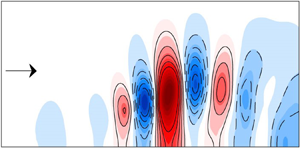Crossref Citations
This article has been cited by the following publications. This list is generated based on data provided by
Crossref.
Zhang, Wei
and
Wei, Mingjun
2021.
Generalized eigenvalue approach for dynamic mode decomposition.
AIP Advances,
Vol. 11,
Issue. 12,
Sashittal, Palash
and
Bodony, Daniel J.
2021.
Data-driven sensor placement for fluid flows.
Theoretical and Computational Fluid Dynamics,
Vol. 35,
Issue. 5,
p.
709.
Faiella, Matthew
Grant Jeon Macmillan, Corwin
Whitehead, Jared P
and
Pan, Zhao
2021.
Error propagation dynamics of velocimetry-based pressure field calculations (2): on the error profile.
Measurement Science and Technology,
Vol. 32,
Issue. 8,
p.
084005.
Kou, Jiaqing
and
Zhang, Weiwei
2021.
Data-driven modeling for unsteady aerodynamics and aeroelasticity.
Progress in Aerospace Sciences,
Vol. 125,
Issue. ,
p.
100725.
Yuan, Yuan
Zhou, Kaiwen
Zhou, Wenwu
Wen, Xin
and
Liu, Yingzheng
2021.
Flow prediction using dynamic mode decomposition with time-delay embedding based on local measurement.
Physics of Fluids,
Vol. 33,
Issue. 9,
Sashittal, Palash
and
Bodony, Daniel J.
2021.
Data-Driven Sensor Placement for Fluid Flows.
Dotto, A.
Lengani, D.
Simoni, D.
and
Tacchella, A.
2021.
Dynamic mode decomposition and Koopman spectral analysis of boundary layer separation-induced transition.
Physics of Fluids,
Vol. 33,
Issue. 10,
Asztalos, Katherine J.
Dawson, Scott T. M.
and
Williams, David R.
2021.
Modeling the Flow State Sensitivity of Actuation Response on a Stalled Airfoil.
AIAA Journal,
Vol. 59,
Issue. 8,
p.
2901.
Otto, Samuel E.
and
Rowley, Clarence W.
2021.
Koopman Operators for Estimation and Control of Dynamical Systems.
Annual Review of Control, Robotics, and Autonomous Systems,
Vol. 4,
Issue. 1,
p.
59.
Heide, Alexander L.
Asztalos, Katherine J.
Dawson, Scott T.
and
Hemati, Maziar
2022.
A low-order nonlinear model of a stalled airfoil from data: Exploiting sparse regression with physical constraints.
Sinclair, Owen
Turner, James
Nicholls, Chris
Tang, Brian
and
Bacic, Marko
2022.
Identification and Closed-Loop Control of a Backwards Facing Step by Opposite Side Acoustic Excitation.
Inoba, Ryoma
Uchida, Kazuki
Iwasaki, Yuto
Nagata, Takayuki
Ozawa, Yuta
Saito, Yuji
Nonomura, Taku
and
Asai, Keisuke
2022.
Optimization of sparse sensor placement for estimation of wind direction and surface pressure distribution using time-averaged pressure-sensitive paint data on automobile model.
Journal of Wind Engineering and Industrial Aerodynamics,
Vol. 227,
Issue. ,
p.
105043.
Sashidhar, Diya
and
Kutz, J. Nathan
2022.
Bagging, optimized dynamic mode decomposition for robust, stable forecasting with spatial and temporal uncertainty quantification.
Philosophical Transactions of the Royal Society A: Mathematical, Physical and Engineering Sciences,
Vol. 380,
Issue. 2229,
Wu, Wen
Meneveau, Charles
Mittal, Rajat
Padovan, Alberto
Rowley, Clarence W.
and
Cattafesta, Louis
2022.
Response of a turbulent separation bubble to zero-net-mass-flux jet perturbations.
Physical Review Fluids,
Vol. 7,
Issue. 8,
Zheng, Changdong
Xie, Fangfang
Ji, Tingwei
Zhang, Xinshuai
Lu, Yufeng
Zhou, Hongjie
and
Zheng, Yao
2022.
Data-efficient deep reinforcement learning with expert demonstration for active flow control.
Physics of Fluids,
Vol. 34,
Issue. 11,
Susuki, Yoshihiko
Shimomura, Takahiro
Ota, Yutaka
and
Ishigame, Atsushi
2022.
Online Koopman Mode Decomposition for Power System Synchrophasor Data.
IFAC-PapersOnLine,
Vol. 55,
Issue. 9,
p.
54.
Xu, Xianzhang
Gementzopoulos, Antonios
Sedky, Girguis
Jones, Anya R.
and
Lagor, Francis D.
2023.
Design of optimal wing maneuvers in a transverse gust encounter through iterated simulation or experiment.
Theoretical and Computational Fluid Dynamics,
Vol. 37,
Issue. 4,
p.
465.
Bakhtiaridoust, Mohammadhosein
Yadegar, Meysam
and
Meskin, Nader
2023.
Data-driven fault detection and isolation of nonlinear systems using deep learning for Koopman operator.
ISA Transactions,
Vol. 134,
Issue. ,
p.
200.
Koo, Bonchan
Chang, Seungjoon
Kim, Hyoung-Ho
and
Park, Sung Goon
2023.
Physics-regulated dynamic mode decomposition for natural gas pipeline flow.
Physics of Fluids,
Vol. 35,
Issue. 9,
Li, Cruz Y.
Chen, Zengshun
Weerasuriya, Asiri Umenga
Zhang, Xuelin
Lin, Xisheng
Zhou, Lei
Fu, Yunfei
and
Tse, Tim K.T.
2023.
Best practice guidelines for the dynamic mode decomposition from a wind engineering perspective.
Journal of Wind Engineering and Industrial Aerodynamics,
Vol. 241,
Issue. ,
p.
105506.

 $Re_c = 0.9\times 10^5$,
$Re_c = 0.9\times 10^5$,  $Re_c = 1\times 10^5$,
$Re_c = 1\times 10^5$,  $Re_c = 1.1\times 10^5$ and
$Re_c = 1.1\times 10^5$ and  $Re_c = 1.25\times 10^5$. All controlled cases exhibit a significant reduction in mean separation bubble height, requiring approximately 10 characteristic time periods to establish control.
$Re_c = 1.25\times 10^5$. All controlled cases exhibit a significant reduction in mean separation bubble height, requiring approximately 10 characteristic time periods to establish control.

